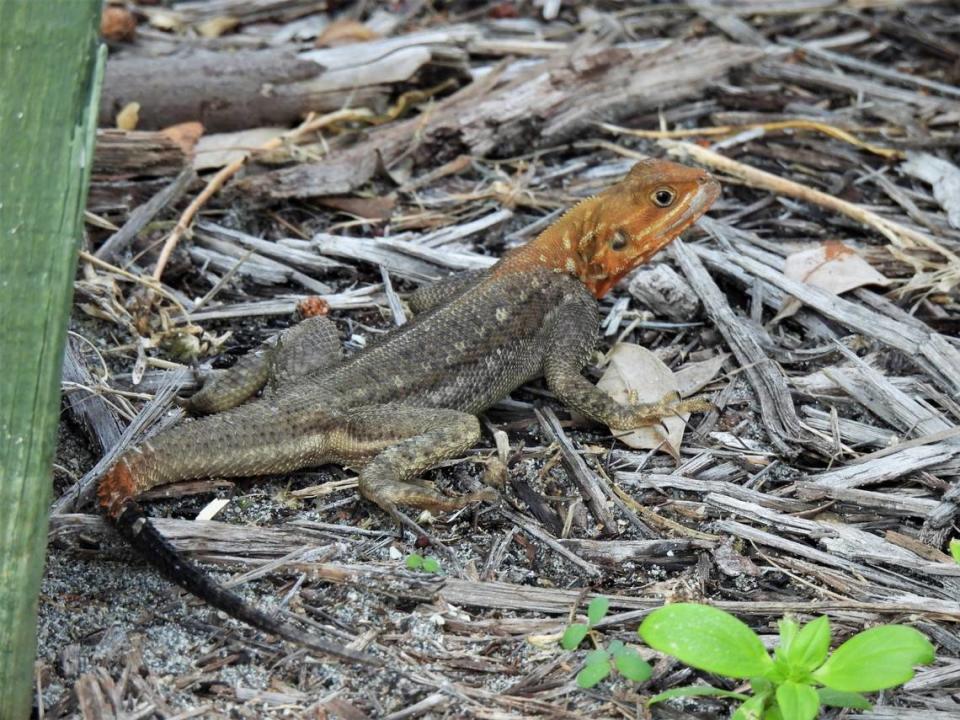Another invasive spreads in Florida: A red-headed lizard with an appetite for butterflies
When scientists at the University of Florida noticed a recent increase in sightings of a flashy red-headed lizard, they knew it was time to ask the public for help in fighting yet another invader.
A surge of emails to the university’s Institute of Food and Agricultural Sciences Extension from people all over South Florida asking for identification of the reptile was a sign that the Peter’s rock agama lizard, an invasive species from Africa, was multiplying and its range appeared to be expanding, with observation reports from as far south as Big Pine Key.
A big problem is that they love insects, including butterflies. That may spell trouble for South Florida’s endangered butterfly species, including some that live in developed areas where the exotic lizard prefers to hang out.
“At this point we don’t see the agama as a huge threat to local wildlife like the Burmese python or the tegu, but we know that the populations are growing in South Florida, and we know they eat insects and other invertebrates,” said Steven Johnson, a UF/IFAS associate professor of wildlife and ecology who just co-authored a new report and fact sheet on the species. “ We want to involve citizen scientists to help us understand more about this lizard.”
The Agama picticauda lizards are colorful — especially when they are breeding — and can grow to about a foot. In Florida, adult males have bold orange or red heads, a black or dark gray body, and a tail that often has an orange stripe and black tip.

Scientists are just starting to map out their distribution, but it appears that agamas tend to prefer urbanized areas rather than the Everglades, though they have been spotted surrounding the national park. South Florida residents have probably seen at least one of these colorful lizards perched on a light post or strolling around a parking lot.
Although their diet in Florida hasn’t been studied yet, evidence from their native range shows that agamas feed on a variety of bugs and small invertebrates. Unlike invasive iguanas, which are much more numerous and eat plants, the agama prefers insects.
Listen to today's top stories from the Miami Herald:
Subscribe: Apple Podcasts | Spotify | Amazon Alexa | Google Assistant | More options
“We have seen video footage of a large male attempting to eat a monarch butterfly. Though the butterfly escaped, it lost a wing and likely died shortly thereafter,” said the report. The agama may also eat other invaders like the Cuban brown anole, and in their native range of East Africa they have been observed eating small mammals, birds, small reptiles, fruits and vegetation such as flowers and grass.
A flooded Everglades: Boon for birds but high waters threaten some species
Though there is no evidence to suggest that the agamas are eating local butterflies on a consistent basis, they may eventually share the same habitat as the endangered Florida Leafwing and the gray Bartram’s Hairstreak, which live in pine rockland forests in Miami-Dade, Johnson said.
And because the agamas are also in the Keys, scientists are concerned they may decide to have a taste of one of the rarest insects in the US, the Miami blue butterfly. But the risk is low because the last pockets of the little bug are in undisturbed areas like Long Key and Bahia Honda state parks, too wild for the apparently city-loving agama, Johnson said. In the Keys, multiple sightings have been registered in Key Largo, Marathon and Big Pine Key.
The agama was first introduced to Florida in 1976 through the pet trade. After escaping or being released or both, sub-populations started growing in Homestead and several areas in Miami-Dade County. South Florida offered the perfect spot for resettlement: a hospitable subtropical climate and large areas of disturbed habitat.
“We are the global epicenter of reptile invasive species introduction,” Johnson said.
The lizards hitched rides on trucks and even trains and spread north, being recently spotted in locations from Martin County to Brevard County and as far north as Jacksonville, according to information from sightings by the public reported on a multi-agency website managed by the University of Georgia.
Florida is home to more non-native species of reptiles and amphibians than anywhere else in the world. South Florida is especially at risk because of its thriving trade in exotic pets. Although pythons have become the symbol of the state’s losing battle against invasives, non-native lizards also pose a significant threat to native wildlife and ecosystems. Tegu lizards, for example, are happy in many different environments including the Everglades and will eat almost everything, including small mammals, bird eggs, fruit, insects and even pet food.
Johnson said the public can engage in citizen science by reporting Peters’s rock agama sightings using the EDDMapS website.

